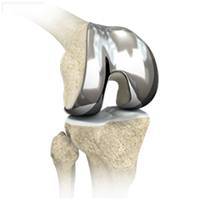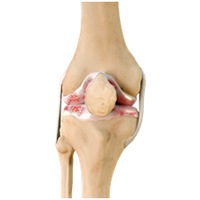Total knee replacement (TKR) is a surgical procedure in which the worn out or damaged surfaces of the knee joint are removed and replaced with new artificial parts.

The knee is made up of - the femur (thigh bone), the tibia (shin bone), and patella (kneecap). The meniscus, a soft cartilage between the femur and tibia serves as a cushion and helps absorb shock during motion. Arthritis (inflammation of the joints), injury, or other diseases of the joint can damage this protective layer of cartilage, causing extreme pain and difficulty in performing daily activities. Arthritis is a general term covering numerous conditions where the joint surface or cartilage wears out. In an arthritic knee
- The cartilage lining is thinner than normal or completely absent. The degree of cartilage damage and inflammation varies with the type and stage of arthritis.
- The capsule of the arthritic knee is swollen.
- The joint space is narrowed and irregular in outline; this can be seen in an X-ray image.
- Bone spurs or excessive bone can also build up around the edges of the joint.

The combinations of these factors make the arthritic knee stiff and limit activities due to pain or fatigue. Your doctor may recommend TKR if non-surgical treatment options have failed to relieve the symptoms.
Surgical Procedure
The goal of the surgery is to relieve pain and restore the alignment and function of your knee.
Surgery is performed under sterile conditions in the operating theatre under spinal or general anaesthesia. You will be lying on your back and a tourniquet applied to your upper thigh to reduce blood loss.
The surgeon makes an incision along the affected knee exposing the knee joint.
- The surgeon first concentrates on the femur (thighbone). The damaged portions of the femur are then cut at the appropriate angles using specialized jigs.
- The femoral component is attached to the end of the femur with or without bone cement.
- The damaged area of the tibia (shinbone) and the cartilage are cut or shaved. This removes the deformed part of the bone and bony growth, as well as allows for a smooth surface for which to attach the implants.
- The tibial component is secured to the end of the bone with bone cement or screws depending on a number of factors and on surgeons’ choice.
- The surgeon will place a plastic piece called an articular surface between the implants to assure a smooth gliding movement. This plastic insert will support the body’s weight and allow the femur to move over the tibia similar to the original cartilage (meniscus).
- The femur and the tibia with the new components are put together to form the new knee joint.
- To make sure the patella (knee cap) glides smoothly over the new artificial knee, its rear surface is prepared to receive a plastic component.
- With all the new components the knee joint is tested through its range of motion.
- All excess cement will be removed. The entire joint will be irrigated or cleaned with a sterile saline solution. The knee is then carefully closed and drains usually inserted and the knee dressed and bandaged.
Post-Operative Recovery
Common Post-Operative guidelines include:
- You will be taken to the recovery room and monitored for any complications.
- You will be given pain medication to keep you comfortable at home.
- You will need someone to drive you home due to the drowsy effects of the anaesthesia.
- Swelling is normal after knee surgery. Ice, compression, and elevation of the knee will be used to minimize swelling and pain.
- You will be given specific instructions regarding activity. Usually there are few activity restrictions.
- You will be referred to a rehabilitation program for exercise and strengthening.
- Eating a healthy diet and not smoking will promote healing.
Risks and complications
As with any major surgery, possible risks and complications associated with total knee replacement surgery include:
- Knee stiffness
- Infection
- Blood clots (deep vein thrombosis)
- Nerve and blood vessel damage
- Ligament injuries
- Patella (kneecap) dislocation
- Plastic liner wears out
- Loosening of the implant
